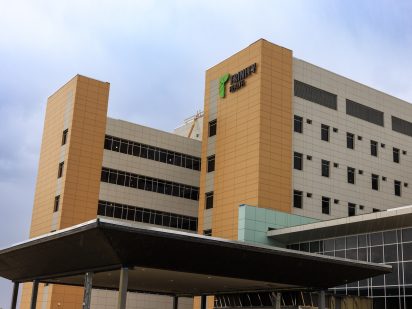It takes a ton of materials to run a healthcare system. Making sure that those supplies, equipment and other goods are procured and delivered at the right time is the role of Supply Chain Management.
Trinity Health’s Supply Chain team appears to have as much longevity and experience as they have storage units. “Our mission is to deliver the highest value in supplies and equipment to support patient care,” said Carol Walth, who brings 36 years of experience to the Supply Chain mission, 17 years as director.
With Trinity Health poised to open its new healthcare campus next spring, Walth says her team sees an opportunity to achieve new heights of efficiency and effectiveness.
“A major change is that our warehouse will be on site; that’s going to be huge,” she said. “Par levels and deliveries will be able to occur in a more timely manner. There won’t be as many STAT calls or delays. Now, if a department needs something from the warehouse it might take 15 to 20 minutes to get it there. At the new campus, we’ll be right on site.”
Supply Chain Management will be located on the first floor-rear of the new hospital, perfectly positioned next to Central Processing, where medical/surgical instruments are cleaned, processed, stored and dispensed for patient care. “It’ll be a one-stop shop for the instrumentation,” Walth added.
Another advantage will be better vendor access. “We’ll have better communication between our buyers here in the department and hospital staff,” she said. “They’ll be able to come and look at whatever we’re ordering instead of us trying to describe something over the phone.”
A major improvement at the new campus will be multiple docks for unloading trucks. “Currently we have just a single dock; the new hospital will have four,” Walth noted. “Two will be recessed so a semi truck can back up to the bay and be even with the dock. Another will be raised to accommodate box trucks, and a fourth will be ground level to allow miscellaneous trucks, such as the type Nutrition Services uses, to pull in and offload from the side.”
Multiple docks will help to eliminate wait time since more than one vendor can be accommodated at the same time. And trucks won’t have to show up as early in the day. In addition to the four main docks, garbage and waste will be dispatched via a separate dock.
Trinity’s Supply Chain team looks forward to enhancing its role regarding wastage reduction, maintaining inventory and preventing medical supplies from expiring in storage. The plan is to adopt a new system for maintaining PAR levels. PAR, which stands for periodic automatic replacement, is an inventory control system that tells a department what levels of inventory it should have in stock in order to fulfill demand. This is especially important in healthcare.
“We’re changing the PAR level,” Walth explained. “It’ll still be a PAR level, but we’ve gone to what they call a Kanban or a two-bin system. Instead of having to count everything daily, the PAR level of each item will be split into two bins. If the front bin is empty, staff will place it on the top shelf in their PAR room. We will pull the bin, replenish it, and move the back one to the front. It should save time and should also facilitate the rotation of supplies.”
And when medical professionals have all the supplies they require, they provide better, more efficient patient care.

